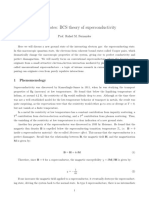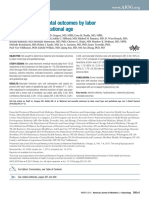Marriage - Fertility and Births Handout
Marriage - Fertility and Births Handout
Uploaded by
untung jakaCopyright:
Available Formats
Marriage - Fertility and Births Handout
Marriage - Fertility and Births Handout
Uploaded by
untung jakaOriginal Title
Copyright
Available Formats
Share this document
Did you find this document useful?
Is this content inappropriate?
Copyright:
Available Formats
Marriage - Fertility and Births Handout
Marriage - Fertility and Births Handout
Uploaded by
untung jakaCopyright:
Available Formats
Marriage, Fertility and Births
in a Northern District of Bangladesh
M. Rashid1, A.B. Labrique2, A.B. Massie2, A.A.Shamim1, A.Huq1, Parul Christian2, Rolf W. Klemm2, K.P West, Jr.2
1 JiVitA Bangladesh (NIPHP), 2 Center for Human Nutrition Johns Hopkins University Bloomberg School of Public Health
Background Results Figure 1. Seasonal Variation in Pregnancy Events
Several studies in Bangladesh have documented the seasonal The mean age for all pregnant women was 25 years 5 months, 0.1
Conceptions (N=32,214)
variations in marriages, conceptions, births and other pregnancy while the mean for newly married pregnant women was exactly 16 Births (N=17,629)
MC (N=3,419)
outcomes. The reasons for the seasonality of some of these events years. Around 43% of all women had some schooling and only 10% 0.09 MR (N=5,688)
SB (N=781)
are not well understood and many hypotheses have been postulated, were involved in any income-generating activities. In contrast, 76.6% Marriage (N=10,289)
0.08
ranging from agricultural demands on the workforce to contraceptive of the cohort of newly married women had some schooling, and 5%
availability and access. were generating income for their families. Husbands of newly married 0.07
women were also better educated (59.6% with some schooling) than
Bangladesh, one of the most successful examples of social the husbands of the general population of married women (43.2%). 0.06
Proportion
marketing of contraceptives, boasts a 54% contraceptive prevalence
(UNFPA, 2002). However, more research is warranted into the A peak in marriage was seen in July in both years. Among the 0.05
behaviors of newly married women and couples and the contraceptive entire population of eligible women of reproductive age, we observed
choices available to prevent unwanted pregnancies and empower an increase in conceptions in the months of March/April in both years, 0.04
couples to delay pregnancy, if so desired. followed by a spike in miscarriages shortly after. MRs also closely 0.03
follow the onset of pregnancies, as expected. A peak in stillbirths is
Since JiVitA actively enrolls newly married women who move observed shortly before the peak birth season in October/ November/ 0.02
into the study area within 4 months of their marriage date, we have a December. (Figure 1)
unique opportunity not only to characterize seasonal patterns of 0.01
marriage, pregnancy and associated outcomes, but also to Time to Pregnancy
0
characterize the reproductive health patterns of these newly married Among 9,708 newly married women on whom data were Sep Oct Nov Dec Jan Feb Mar Apr May Jun Jul Aug Sep Oct Nov Dec Jan Feb Mar Apr May Jun Jul Aug Sep Oct
women. available, a life table analysis (Table 1) revealed that 25% of the 2001 2002 2003
cohort became pregnant by the end of their 6th month after marriage,
and 50% by the 13 th post-nuptial month. At the end of two years, only
30% had not become pregnant (Figure 2).
Objectives Table 2. Contraceptive Use Patterns Among Conclusions
At the time of their first trimester enrollment interview, about
• To describe the seasonality of 44% of newly married women and 37% of their husbands indicated Newly Married and Multigravid The patterns of seasonality of marriage, conceptions and
marriage, conception and pregnancy they had not wanted the pregnancy. In 35% of couples, both husband Women by Wantedness of Pregnancy births seen in Gaibandha are comparable to findings from Matlab in
outcomes in the northern rural District and wife expressed a desire to have delayed the current pregnancy. southern Bangladesh (Becker et al, Pop Stud 1986) and Haryana,
of Gaibandha over a period of two Despite this, within families where neither partner wanted pregnancy, India (Anand et al, Ind Ped 2000). The study community is
years of population surveillance, 88.4% were not practicing any method of contraception (Table 2). predominantly agrarian, so seasonality of marriage, conception and
• To characterize the time between Most commonly used in this group were oral contraceptive pills birth may be explained in part by the sowing and harvesting
marriage and pregnancy among (OCPs) (9.1%), with condoms being used by only 2.2% of couples. seasons. A marriage peak in July occurs soon after the ‘Boro’ rice
newly married women and This contrasts sharply with practices among multigravid women harvest (during April-May), when farmers have money to arrange
among whom 34.3% reported use of OCPs and 7.4% injectables. marriage ceremonies.
• To explore contraceptive choices by
these newly married women in light of As the cohort of newly married women has not been followed
wantedness of pregnancy. for sufficient time, pregnancy event seasonality was looked at using
data from all enrolled women of reproductive age. The peak of births
Table 1. Life Table of Pregnancy Events in “Newly in October/ November/ December corresponds with a peak in
conceptions in March/April. The drop in marriages and conceptions
Married Women”, Between 9/2001 and 9/2003
Methods in winter may reflect the ‘Aman’ harvest and ‘Boro’ sowing seasons,
when women’s participation in fieldwork increases.
The JiVitA study is following 113,060 married women of
reproductive age for incident pregnancies in 19 Unions of rural The lifetable analysis shows that newly married women
Gaibandha and Rangpur Districts. Since the study’s onset in July become pregnant very soon after marriage; half the cohort were
2001, 35701 newly pregnant women have been enrolled and visited pregnant within the first year of their marriage. However, within this
weekly by locally hired and trained female workers called Field group, more than one third of couples reported not wanting their
Distributors (FD). Every 5 weeks, the FDs conduct house-to-house pregnancy. Contraceptive use, however, among these newlyweds
surveillance of all enumerated married women of reproductive age to does not reflect well the expressed desire for delayed conception
identify incident pregnancies and to enroll newly married women Figure 2. Cumulative pregnancies by Time (Months) (Table 2, Column 1). This contrasts sharply with high contraceptive
entering the study area. since Marriage use documented in the general population of multigravid married
women (Table 2, Column 3).
To date, 10278 newly married women have been enrolled into
the JiVitA-1 trial. Data from enrolled women was used to look at There may be several reasons that newly married women are
seasonality of marriage, conception and pregnancy outcomes, not better empowered to control their first pregnancy, including family
including livebirths, stillbirths, miscarriages and premature and social pressures, restricted access to information, or even non-
terminations of pregnancy. Proportionate distributions of these events availability of methods. This phenomenon may also represent a
over a 25-month period were plotted to determine seasonality of these missed opportunity for family planning interventions to target birth
events. Approximate dates of conception have been extrapolated by control counseling to newly married couples in this population.
shifting the dates of pregnancy enrollment back by eight weeks, which
is the average delay between conception and enrollment.
A lifetable analysis was used to explore the distribution of time Acknowledgements
to pregnancy after marriage among 9708 newly married women on
whom data was available. In an effort to ascertain whether newly The financial support of the United States Agency for International
married couples delay their first pregnancy through contraception, we Development (USAID), the Bill and Melinda Gates Foundation, the
explored the contraceptive use of pregnant women who reported that Sight and Life Research Institute, Micronutrient Initiative and the
neither spouse wanted the pregnancy. Government of Bangladesh is acknowledged.
You might also like
- Occupational Therapy With Elders-Strategies For The COTA, 3e PDFDocument985 pagesOccupational Therapy With Elders-Strategies For The COTA, 3e PDFConsueloAstetePaulmann100% (9)
- Basic Geriatric Nursing 6th Williams Test BankDocument7 pagesBasic Geriatric Nursing 6th Williams Test BankRamiqq0% (1)
- Daycare Tie-Up at TCS Bangalore1Document5 pagesDaycare Tie-Up at TCS Bangalore1nagammaiNo ratings yet
- Paragraf CalismalariDocument100 pagesParagraf CalismalariUfukŞahinNo ratings yet
- স্থানাঙ্ক-জ্যামিতি-উচ্চতর-গণিত-নবম-দশম-শ্রেণি-একাদশ-অধ্যায়-নোটDocument56 pagesস্থানাঙ্ক-জ্যামিতি-উচ্চতর-গণিত-নবম-দশম-শ্রেণি-একাদশ-অধ্যায়-নোটR PNo ratings yet
- ঘন-জ্যামিতি-উচ্চতর-গণিত-নবম-দশম-শ্রেণি-ত্রয়োদশ-অধ্যায়-নোটDocument32 pagesঘন-জ্যামিতি-উচ্চতর-গণিত-নবম-দশম-শ্রেণি-ত্রয়োদশ-অধ্যায়-নোটR PNo ratings yet
- ေသာင္းေဝဦး စစ္သားဘဝအမွတ္တရမ်ား ၂Document233 pagesေသာင္းေဝဦး စစ္သားဘဝအမွတ္တရမ်ား ၂Tun Lin Maung100% (5)
- The Indian Financial System Bharati v. Pathak WWW - Indianpdf.com Download Book Novel PDF Online FreeDocument631 pagesThe Indian Financial System Bharati v. Pathak WWW - Indianpdf.com Download Book Novel PDF Online FreeWinsomeboi HoodlegendNo ratings yet
- Hasa Khusi II PDFDocument100 pagesHasa Khusi II PDFjohn4jNo ratings yet
- 1 PG TRB Physics Unit 1 MatrixDocument10 pages1 PG TRB Physics Unit 1 Matrixilayaraja6No ratings yet
- PSTM Certificate Format - SchoolDocument1 pagePSTM Certificate Format - SchoolFood ReviewNo ratings yet
- Lecture Notes BCSDocument25 pagesLecture Notes BCSRai OttoNo ratings yet
- 2020 Calendar PDFDocument12 pages2020 Calendar PDFDinakaranNo ratings yet
- Physics-Lamlad's SSCE & UTME Physics-O Ajaja, HB Olaniyi-1999Document237 pagesPhysics-Lamlad's SSCE & UTME Physics-O Ajaja, HB Olaniyi-1999hardebolzem12No ratings yet
- 1921-Article Text-5207-2-10-20231102Document4 pages1921-Article Text-5207-2-10-20231102kkqx952569No ratings yet
- Hubungan Dukungan Suami Dengan Kecemasan Ibu Hamil Dalam Menghadapi Proses PersalinanDocument7 pagesHubungan Dukungan Suami Dengan Kecemasan Ibu Hamil Dalam Menghadapi Proses PersalinanChandra Dwi FitrianiNo ratings yet
- Racial Disparity in Previable BirthDocument7 pagesRacial Disparity in Previable Birthjojhan.andres02No ratings yet
- Optimal Birth Spacing: What Can We Measure and What Do We Want To Know?Document3 pagesOptimal Birth Spacing: What Can We Measure and What Do We Want To Know?rizmahNo ratings yet
- Late PretermDocument6 pagesLate PretermzunarodriguezleoNo ratings yet
- Readiness of Teenage Pregnant Women in Sukowono, Jember)Document8 pagesReadiness of Teenage Pregnant Women in Sukowono, Jember)Sisi KurniaNo ratings yet
- Assignment English Summary About Guided ImageryDocument23 pagesAssignment English Summary About Guided Imagerymufid dodyNo ratings yet
- Gestational Age and Birth Weight Centiles of Singleton Babies Delivered Normally Following Spontaneous Labor, in Southern Sri LankaDocument7 pagesGestational Age and Birth Weight Centiles of Singleton Babies Delivered Normally Following Spontaneous Labor, in Southern Sri Lankamohamad safiiNo ratings yet
- Sdarticle 131Document2 pagesSdarticle 131Rio Michelle CorralesNo ratings yet
- IndianJObstetGynecolRes 11-2-264 269Document6 pagesIndianJObstetGynecolRes 11-2-264 269Anitha AnithaNo ratings yet
- Induction of Labor and Factors Associated With Its Outcome in Ethiopia A Systemic Review and MetaanalysisDocument7 pagesInduction of Labor and Factors Associated With Its Outcome in Ethiopia A Systemic Review and MetaanalysisFikaduNo ratings yet
- Mode of Delivery in Previable BirthsDocument9 pagesMode of Delivery in Previable Birthsjojhan.andres02No ratings yet
- Depression Among Pregnant Women and Associated Factors in Hawassa City, Ethiopia: An Institution-Based Cross-Sectional StudyDocument6 pagesDepression Among Pregnant Women and Associated Factors in Hawassa City, Ethiopia: An Institution-Based Cross-Sectional Studyevita juniarNo ratings yet
- A Case Control Study of Risk Factors For Low Birth Weight in Nagpur City of MaharashtraDocument4 pagesA Case Control Study of Risk Factors For Low Birth Weight in Nagpur City of MaharashtraAdib FraNo ratings yet
- Impact On Perceived Postnatal Support, Maternal Anxiety and Symptoms 2012Document8 pagesImpact On Perceived Postnatal Support, Maternal Anxiety and Symptoms 2012jahnavinavamiNo ratings yet
- Infertility A Review On Causes Treatment and ManagementDocument19 pagesInfertility A Review On Causes Treatment and Managementreza tryasNo ratings yet
- Madazli 2014Document4 pagesMadazli 2014Emily PrincessaNo ratings yet
- Serafini - Outcome and Follow Up of Children Born After IVF-surrogacyDocument5 pagesSerafini - Outcome and Follow Up of Children Born After IVF-surrogacyBelénNo ratings yet
- Stern Et Al., 2015Document6 pagesStern Et Al., 2015floyaaNo ratings yet
- Global: The Importance of Skin-To-Skin Contact For Early Initiation of Breastfeeding in Nigeria and BangladeshDocument13 pagesGlobal: The Importance of Skin-To-Skin Contact For Early Initiation of Breastfeeding in Nigeria and BangladeshGina RestianaNo ratings yet
- Active Husband Involvement During Pregnancy - A Grounded TheoryDocument40 pagesActive Husband Involvement During Pregnancy - A Grounded TheoryshahanasNo ratings yet
- Prevalence of Neonatal Resuscitation in YaoundcameroonDocument4 pagesPrevalence of Neonatal Resuscitation in YaoundcameroonScivision PublishersNo ratings yet
- Acta Obstet Gynecol Scand - 2018 - M Ller - Reproduction Fear of Childbirth and Obstetric Outcomes in Women Treated ForDocument8 pagesActa Obstet Gynecol Scand - 2018 - M Ller - Reproduction Fear of Childbirth and Obstetric Outcomes in Women Treated ForsilviaNo ratings yet
- 1.efect of Prenatal Care On Obstretrical OutcomeDocument9 pages1.efect of Prenatal Care On Obstretrical OutcomeGeorgiana DNo ratings yet
- Maternal Sleep PracticesDocument11 pagesMaternal Sleep Practicesatikha apriliaNo ratings yet
- Mindfulness Based Childbirth and Parenting For Pregnant Women With H - 2023 - MiDocument11 pagesMindfulness Based Childbirth and Parenting For Pregnant Women With H - 2023 - MiAt PrimaNo ratings yet
- 2- Pretrem labor_MadhusmitaDocument8 pages2- Pretrem labor_MadhusmitaMadhusmita NayakNo ratings yet
- Sha Char 2014Document5 pagesSha Char 2014Mahlina Nur LailiNo ratings yet
- Pi Is 0002937810000815 JournallDocument12 pagesPi Is 0002937810000815 JournallRaisa AriesthaNo ratings yet
- 1 s2.0 S0140673623006888 MainDocument11 pages1 s2.0 S0140673623006888 MainLavinaNo ratings yet
- Jurnal Stikes A YaniDocument9 pagesJurnal Stikes A YaniArkha BheluNo ratings yet
- Hubungn Miom Dengan IUGRDocument14 pagesHubungn Miom Dengan IUGRRizqon Yasir KoeswondoNo ratings yet
- Assessment of Grief in Mothers With Pregnancy Loss and Role of Post Bereavement Counselling: A Prospective StudyDocument4 pagesAssessment of Grief in Mothers With Pregnancy Loss and Role of Post Bereavement Counselling: A Prospective StudyDiegoNo ratings yet
- 3.A5 Faktor Tingkat Umgres Jurnal 1Document9 pages3.A5 Faktor Tingkat Umgres Jurnal 1aliNo ratings yet
- Dichorionic Twin Trajectories The NICHD Fetal GroDocument16 pagesDichorionic Twin Trajectories The NICHD Fetal GroRenéNo ratings yet
- 3854 ID Peran Suami Selama Proses Kehamilan Sampai Nifas IstriDocument7 pages3854 ID Peran Suami Selama Proses Kehamilan Sampai Nifas Istrisutikno13010126No ratings yet
- Hubungan Dukungan Suami Dengan Kunjungan Aantenatal Care Pada Ibu HamilDocument9 pagesHubungan Dukungan Suami Dengan Kunjungan Aantenatal Care Pada Ibu HamilWIDANINGSIH -No ratings yet
- 845-Article Text-1669-1-10-20181012Document6 pages845-Article Text-1669-1-10-20181012IffahNo ratings yet
- Linear Association Between Maternal Age and Spontaneous 5b8pd23srcDocument11 pagesLinear Association Between Maternal Age and Spontaneous 5b8pd23srcBaldeo, Rosbee M.No ratings yet
- NIH Public Access: Contributing Indications To The Rising Cesarean Delivery RateDocument17 pagesNIH Public Access: Contributing Indications To The Rising Cesarean Delivery RatedianaNo ratings yet
- 1 s2.0 S030438781500067X MainDocument10 pages1 s2.0 S030438781500067X Mainshafira.ayu21No ratings yet
- Ojog 2023012915234980Document10 pagesOjog 2023012915234980MICHAEL KEPSEUNo ratings yet
- ajol-file-journals_466_articles_224423_submission_proof_224423-5497-547912-1-10-20220426Document11 pagesajol-file-journals_466_articles_224423_submission_proof_224423-5497-547912-1-10-20220426Kissné Makai KataNo ratings yet
- Maternal Factors For Low Birth Weight AnDocument6 pagesMaternal Factors For Low Birth Weight AnJohns EricNo ratings yet
- Is The Male Involved in The Aetiology of Ectopic Pregnancy?: G.M.Warnes, O.M.Petrucco, R.F.Seamark and P.A.L.LancasterDocument6 pagesIs The Male Involved in The Aetiology of Ectopic Pregnancy?: G.M.Warnes, O.M.Petrucco, R.F.Seamark and P.A.L.LancasterchitranjaliokNo ratings yet
- BJOG - 2005 - Bartellas - Sexuality and Sexual Activity in PregnancyDocument5 pagesBJOG - 2005 - Bartellas - Sexuality and Sexual Activity in Pregnancyศุภชัย ศิลาวัชรพลNo ratings yet
- Brenner 2024Document10 pagesBrenner 2024jessica ArriagadaNo ratings yet
- 10 Sreeja GangadharanDocument12 pages10 Sreeja GangadharanSreeja GangaNo ratings yet
- A Comparative Study of Teenage Pregnancy: S. H. Mahavarkar, C. K. Madhu & V. D. MuleDocument4 pagesA Comparative Study of Teenage Pregnancy: S. H. Mahavarkar, C. K. Madhu & V. D. MuleGeorgiana DNo ratings yet
- The Role of Ultrasound in ObstetricsDocument9 pagesThe Role of Ultrasound in ObstetricsHanun FaizaNo ratings yet
- NCM 114: Care of The Older Adult Instructor: Gino Paulo A. Buizon, R.NDocument9 pagesNCM 114: Care of The Older Adult Instructor: Gino Paulo A. Buizon, R.NJay VillasotoNo ratings yet
- Ryff, C. D. (2014) - Psychological Well-Being Revisited Advances in The Science and Practice of Eudaimonia. Springer Publishing Company.Document31 pagesRyff, C. D. (2014) - Psychological Well-Being Revisited Advances in The Science and Practice of Eudaimonia. Springer Publishing Company.nnovi6883No ratings yet
- Study To Assess The Effectiveness of Structured Teaching Programme Regarding Knowledge On Geriatric Care Among The Gerontological Nurses Working in Selected Old Age Homes in Kanyakumari DistrictDocument10 pagesStudy To Assess The Effectiveness of Structured Teaching Programme Regarding Knowledge On Geriatric Care Among The Gerontological Nurses Working in Selected Old Age Homes in Kanyakumari DistrictAntony Rose AbyNo ratings yet
- Problemsofthe Aged Peoplein IndiaDocument36 pagesProblemsofthe Aged Peoplein IndiaStutes TubeNo ratings yet
- 3 Case Studies in A Park With Playground and Outdoor Fitness GymDocument18 pages3 Case Studies in A Park With Playground and Outdoor Fitness GymTeresa AdralesNo ratings yet
- Anti-Aging InnovationsDocument4 pagesAnti-Aging Innovationsarthurfreelancer063No ratings yet
- Just Keep Calm Take Some Magnesium - Why A "Boring" Mineral Is Suddenly Hot Property For Soothing Bodies and Calming Minds (James Lee (Lee, James) )Document60 pagesJust Keep Calm Take Some Magnesium - Why A "Boring" Mineral Is Suddenly Hot Property For Soothing Bodies and Calming Minds (James Lee (Lee, James) )Eder BernadinoNo ratings yet
- 26 Longevity Boosting Supplements & Drugs To Increase LifespanDocument51 pages26 Longevity Boosting Supplements & Drugs To Increase Lifespanbammer1No ratings yet
- Cuthbert Aging PaperDocument14 pagesCuthbert Aging Papershawnee11No ratings yet
- Frailty What is ItDocument146 pagesFrailty What is Itbbmc308zyNo ratings yet
- Ageing and Life Extension - Oil & Gas UKDocument2 pagesAgeing and Life Extension - Oil & Gas UKaligharaee100% (1)
- BSR455_NAP2467A_REPORTDocument38 pagesBSR455_NAP2467A_REPORTJiji YanaNo ratings yet
- 1st Day Lecture - CHN 2 PDFDocument6 pages1st Day Lecture - CHN 2 PDFR-Chian Jose GermanpNo ratings yet
- M1 Nutrition Throughout The Life CycleDocument9 pagesM1 Nutrition Throughout The Life CycleMariel TulaganNo ratings yet
- Longevity Organizational Report 4-3-17Document25 pagesLongevity Organizational Report 4-3-17Aaron King100% (1)
- Ageing in Society 3rd Edition CompressDocument379 pagesAgeing in Society 3rd Edition CompressTreasa FrancisNo ratings yet
- Healthy and Unhealthy Aging IAGMH INTAS Award ScTiwari, RK Tripathi Aditya KumarDocument30 pagesHealthy and Unhealthy Aging IAGMH INTAS Award ScTiwari, RK Tripathi Aditya KumarDr. Rakesh Kumar TripathiNo ratings yet
- What Happens To The Brain As We AgeDocument11 pagesWhat Happens To The Brain As We AgeMrigank Aggarwal100% (1)
- Geriatric NursingDocument4 pagesGeriatric NursingJe Carmel Marie ElentorioNo ratings yet
- YAFS Further Studies 2016Document20 pagesYAFS Further Studies 2016Merly A. MaGuido100% (1)
- Perspective On Aging IV: Social Psychological Aspects of AgingDocument67 pagesPerspective On Aging IV: Social Psychological Aspects of Agingnilton31No ratings yet
- GenderDocument14 pagesGenderiko552000No ratings yet
- Adolescence EssayDocument2 pagesAdolescence EssayUmar Iyoob100% (8)
- The Conceptual Framework For Increasing Social Activity of Elderly PeopleDocument8 pagesThe Conceptual Framework For Increasing Social Activity of Elderly PeopleAcademic JournalNo ratings yet
- Aging and society Canadian perspectives Eighth Edition Novak download pdfDocument65 pagesAging and society Canadian perspectives Eighth Edition Novak download pdfibrahmaitalaNo ratings yet
- Wang, Angel HeDocument311 pagesWang, Angel HeErfin WatiNo ratings yet

























































































